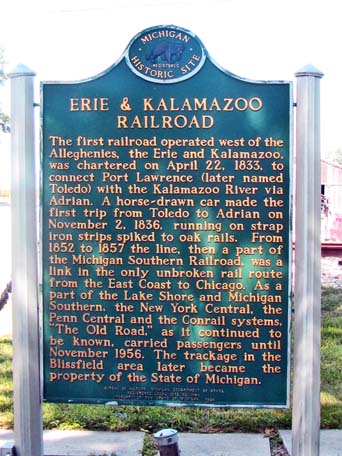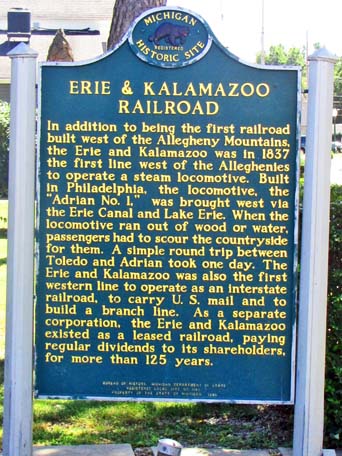

 Erie and Kalamazoo Railroad Historical Marker
Erie and Kalamazoo Railroad Historical Marker
The completion of the Erie Canal in 1825 led to a rapid growth of population and commerce in Michigan since people and goods could travel more easily from the East Coast to the Upper Midwest. On April 22, 1833, entrepreneurs secured a charter from the Michigan Territorial Legislature to build a rail line from Port Lawrence—now known as Toledo—to the mouth of the Kalamazoo River. Presumably, travelers and goods would cross New York State on the Erie Canal, sail on Lake Erie to Port Lawrence, and then use the Erie and Kalamazoo Railroad to reach Lake Michigan where they could sail west to Chicago or Wisconsin. This was the fourth railroad to be chartered by the Michigan territorial legislature, but the first to actually build a line.
On November 2, 1836, the Erie and Kalamazoo opened for business from Port Lawrence to Adrian. It was not what we have in mind when we think of a railroad today. The roadway consisted of oak timbers resting on wooden ties covered with strap iron. A horse pulled a carriage slowly across those rails. Nevertheless, it was the first railroad to operate west of the Alleghenies. The next year, the Erie and Kalamazoo obtained a steam engine built in Philadelphia for their railroad. Using their steam engine, they made one round trip a day between Port Lawrence and Adrian. Recall that Michigan roads at this time were basically trails in the mud with oak planks so the rudimentary rail line was a great improvement.
The mid 1830s were a troubled time for this rail line. President Jackson’s decision to give Toledo to Ohio in hopes of winning electoral votes in Indiana, Ohio and Illinois in the 1836 presidential contest meant that about one-third of the completed part of the Erie and Kalamazoo was located in Ohio, not in Michigan. The line found it difficult to raise capital, so just four months after beginning operation to Adrian, they changed their charter to make that city their western terminus.
Michigan’s first governor, Stephen T. Mason, strongly supported internal improvements and used the new state’s financial credit worthiness, in 1837, to back the building of three rail lines across Michigan. The southern route was to extend from Monroe—then the southernmost Michigan port on Lake Erie—west to either the mouth of the Kalamazoo River or a navigable port on that waterway. Presumably, this state-backed line would pick up where the Erie and Kalamazoo quit in Adrian. This new line was eventually known as the Michigan Southern and then, later, as the Lake Shore and Michigan Southern.
The financial panic of the late 1830s helped to make it challenging for the new road to build west. Eventually, they reached Hillsdale on September 25, 1843, but at that point, the state legislature refused to provide any more financial support for further expansion. Indeed, because the state guaranteed their bonds, the state came to own this unprofitable railroad. The state wished to get out of the rail business so they sold the line, on December 23, 1846, to Michigan investors who agreed to various terms including building a branch line from Hillsdale to Jackson and extending the roadbed to the Kalamazoo River.
The new owners also faced difficulty raising capital so they made progress slowly. By 1850, their rails reached Coldwater and, in 1851, White Pigeon. By this time, they recognized that their most profitable destination was Chicago, not a port on Lake Michigan. A rail line was being built across northern Indiana very proximate to Michigan’s southern border, through present-day Elkhart and South Bend. Rather than building their own line to Chicago, the Michigan Southern found a South Bend investor who would link their line at White Pigeon, Michigan to the railroad that extended from South Bend to Chicago. On October 1852; the Michigan Southern began operating trains from Michigan points to downtown Chicago, using the tracks of other rail lines in northern Indiana and Chicago. To fulfill their obligation to build to the Kalamazoo River, they extended a branch from their main line to the banks of that river at Constantine, Michigan.
By the early 1850s, the Michigan Central and the Michigan Southern were competing to provide service from New York City to Chicago. There were quite a few obstacles. The Michigan Central had to cooperate and support the Great Western Railway of Canada in a line across Ontario on Lake Erie’s north shore. That line was completed on December 25, 1853. A suspension bridge across the Niagara River near Buffalo was completed in March, 1855. That meant that passengers and freight could make an uninterrupted rail trip from New York City to Windsor. After a ferry trip across the Detroit River, the Michigan Central carried them to Chicago. Thus, the Michigan Central played an important role in the development of Detroit in the decade before the emergence of manufacturing in that city.
The entrepreneurs supporting the Michigan Southern had a different strategy. By merging and cooperating with various lines that stretched along the south shore of Lake Erie, they laid out an all-rail route in the United States from New York to Chicago by 1857. Originally, it was an inefficient operation since the rail lines across New York, Pennsylvania and Ohio used different gauges and the route in northern Ohio was exceptionally long since the companies lacked capital to build a bridge across Sandusky Bay. This was not an easy or convenient way to get from New York to Chicago.
The 1860s were very prosperous years for the nation’s railroad and were also an era of consolidation. By 1869, the Lake Shore and Michigan Southern line was formed to provide through service from Buffalo through Erie and Cleveland to Toledo and then across the southern counties of Michigan, only to return to Indiana for the final 100 miles of the journey to Chicago. This line prospered, and in the later 1870s, the Vanderbilts successfully sought to control this valuable property. The railroad also realized that they could save miles if their line went directly west from Toledo to South Bend and avoided the circuitous route through southern Michigan. Such a line was built so the longer route through Adrian, Hillsdale, Coldwater and other Michigan towns became an alternative line. As late as 1946, the line had a mail contract so two round trip passenger/mail trains traveled between Toledo and Elkhart daily. In 1956, passenger service ended. The line remained in operation, albeit substantially downgraded until 1976 when the failure of the Penn Central Railroad and the government bailout meant that redundant and branch lines were pretty much abandoned. The state of Michigan came to own the line and sought operators who would provide freight service where they was sufficient demand. Much of the original Erie and Kalamazoo and Michigan Southern line across the southernmost tier of counties is gone but a short line operator, the Adrian and Blissfield, provides service from Adrian to the grain elevators in Blissfield. The Michigan Southern did not accomplish for Monroe what the Michigan Central did for Detroit. Indeed, the line from Monroe to Adrian was abandoned before World War II.
There is something unusual about this historical maker. There are two historical makers with similar information located along the current Adrian and Blissfield rail line about 100 yards apart.
State of Michigan Registry of Historic Sites: P23, 894 Listed February 18, 1856
State of Michigan Historical Markers: Erected in 1986 and again in 2001
Picture: Ren Farley; August 24, 2010
Description prepared: August, 2010
Return to Transportation
Return to Homepage